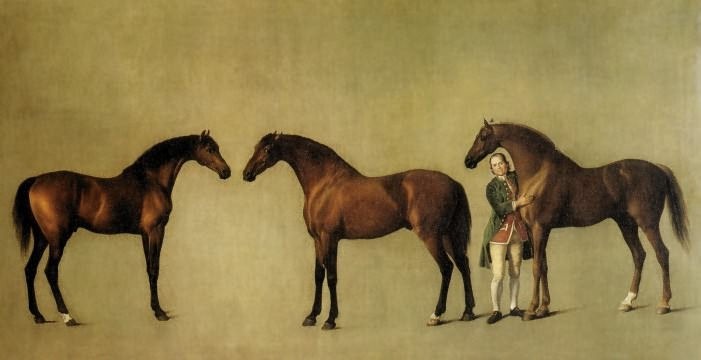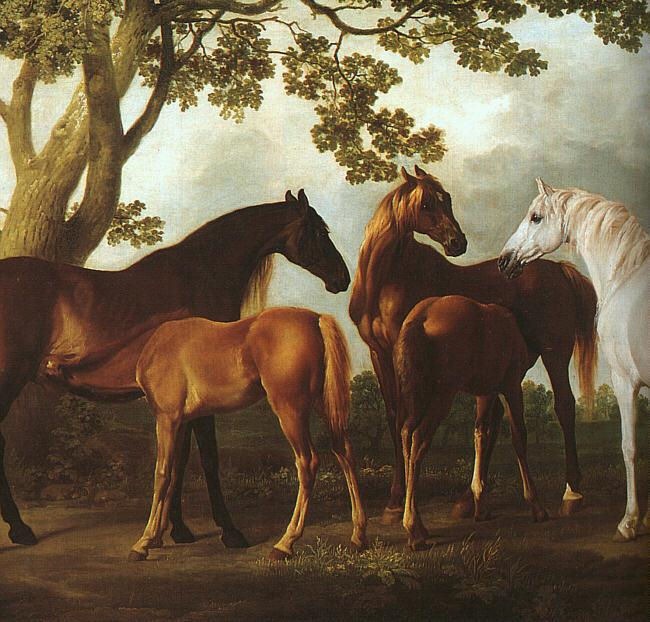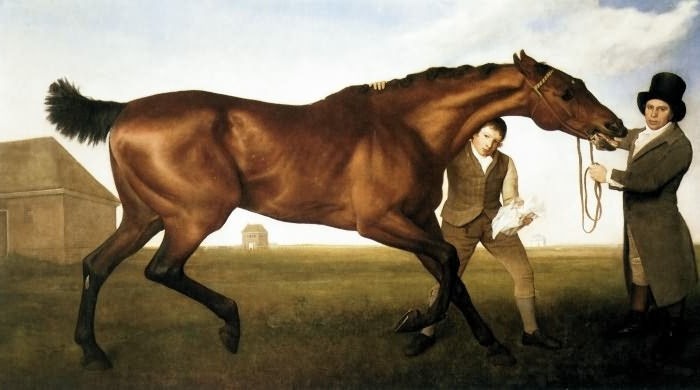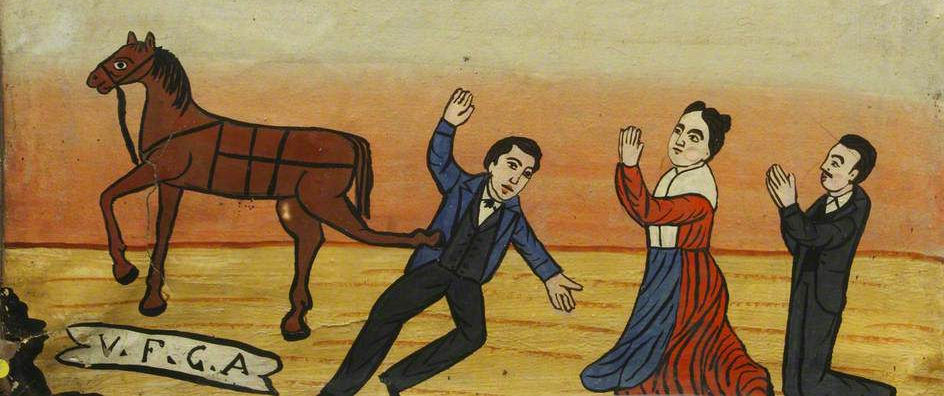Horsemanship Level 2: Equine Warning Signs
Take a look at this painting by George Stubbs. Who is the angry looking bay in the middle threatening: the happy bay in front of him, or the oblivious human and palomino behind him? (Answer below) Reading your horse's moods is one of the most important skills you can develop. Although they don't speak English, horses can communicate quite effectively with their body language. When you've spent enough time around horses you can detect their level of interest, boredom, anxiety and irritation. For safety's sake, though, the first bit of equine grammar you should familiarize yourself with are:
Reading your horse's moods is one of the most important skills you can develop. Although they don't speak English, horses can communicate quite effectively with their body language. When you've spent enough time around horses you can detect their level of interest, boredom, anxiety and irritation. For safety's sake, though, the first bit of equine grammar you should familiarize yourself with are:
6. Signs of a horse about to bite or kick
Horses have two modes of attack, frontal and rearward. Forward attacks, via biting or striking with the forehoof tend to be more aggressive and premeditated, while kicks are often a defence against a perceived threat. That said, some horses do aggressively swing their hind ends around to intimidate, and I've seen some back up to other horses fully planning to start a kicking spree. All horses, no matter how docile, have defensive responses, and it's good to know whether yours tends to be a biter or a kicker, while keeping in mind that all horses have the capability for both.
Signs of an irritated horse:
- ears back
- tension in head and neck
- nostrils 'pinched' or narrow
- tail twitching
- stamping or swinging a foot
A horse that's irritated is not necessarily going to bite or kick, but may be gearing up for it, so use caution. Try to find the source of the irritation, use calm and soothing words, and stay at the horse's shoulder, keeping out of the 'danger zones' in the front and back of the animal.
Signs of a horse about to bite or strike with the forehoof:
- ears pinned back
- snaking neck
- teeth bared
- lifting or swinging foreleg
Signs of a horse about to kick:
- ears pinned back
- head high & neck tense
- eyes turned back, perhaps showing whites
- tail wringing
- swinging hind leg
- swinging hindquarters toward target
Some horses will make a warning noise as well, such as squeal or even a sort of whimper deep in the throat. Horses in general prefer not to fight and risk injury, so their warnings to each other are an important part of conflict prevention.
All the above points apply to an irritated or angry horse. A horse that is suddenly frightened may kick without warning, which is why moving safely around the horse, avoiding the 'kick zone' when possible, is good practice (see last week's post on grooming and common sense).
Equine Expressions
George Stubbs was a keen observer of equine mood, and the horses in his paintings speak volumes.  These nursing mares are not pleased by the happy-go-lucky older gelding or mare that has come by to say hello. The mare on the left is merely disgruntled. Her ears are back but not pinned, and she's telling the intruder she's not interested in chit chat. The mare on the right is clearly put out. Her high head, wide eyes, pinched nostrils and pinned ears tell the grey that if takes one step nearer her head will snake out and she'll take a piece out of him.
These nursing mares are not pleased by the happy-go-lucky older gelding or mare that has come by to say hello. The mare on the left is merely disgruntled. Her ears are back but not pinned, and she's telling the intruder she's not interested in chit chat. The mare on the right is clearly put out. Her high head, wide eyes, pinched nostrils and pinned ears tell the grey that if takes one step nearer her head will snake out and she'll take a piece out of him. The famous racehorse Hambletonian isn't happy either. His snaking neck, pinned ears and bared teeth may be a sign of fear rather than agression in this instance, but if I were his owner I wouldn't be standing in front of him and looking at the painter. (On another note, I will forever be in awe of Stubbs's ability to capture the sheen of a horse's coat on canvas).
The famous racehorse Hambletonian isn't happy either. His snaking neck, pinned ears and bared teeth may be a sign of fear rather than agression in this instance, but if I were his owner I wouldn't be standing in front of him and looking at the painter. (On another note, I will forever be in awe of Stubbs's ability to capture the sheen of a horse's coat on canvas).
Looking back at the triptych at the top of the page we can see that the bay horse on the left is fairly content. His neck is high but relaxed, and his ears are forward in an interested, but not frightened, manner.
The palomino on the left has a bit more tension in him. One ear forward and one back means he's trying to pay attention to everything around him. It's possible the man is moving him backward, which is why he has to turn that ear back in the direction of his movement. (As the study was being done the handler probably had to constantly move the horse back into position).
The fellow in the middle, however, has his eye on something behind him. He's not happy about it, as we can see by the white of his eye, his flattened ears, and the tension in his neck and muzzle. While he's not swinging a hind leg, the muscles in his croup and buttock are bunched as if he's about to move that hind end. This painting was done from three different studies, so the man and horse on the right were never at risk. If it were a single scene, I'd be a lot more more worried about their safety!
June at the Barn
We had yet another gorgeous day for Mounted Combat on Sunday, and loads of fun doing drills and mounted games with both spear and sword as we start to gear up for our Knightly Games Tournament at the end of September. The next Mounted Combat workshop will be Sunday July 7th. Sign up for the July Integrated Package to get ready to ride in the tournament!
Mounted Games Practices
For those of you with a minimum of Riding Level 1, we will be holding Games Practice evenings every Friday from 5-7pm from now till the tournament. This is your chance to up your speed and accuracy -- and enjoy sunny summer evenings at the barn. Cost is $5 if you have your own horse, or $15 with a school horse. Spectators welcome!
Jennifer Landels, Maestra di ScuderiaAcademie Duello Cavaliere Program
